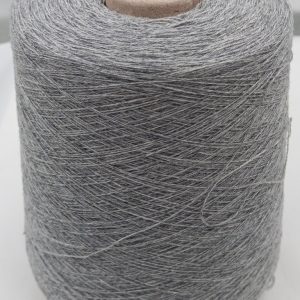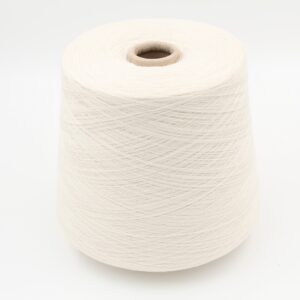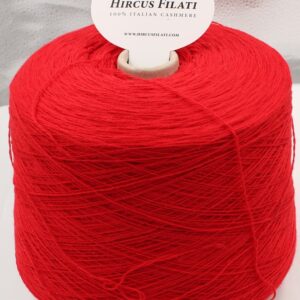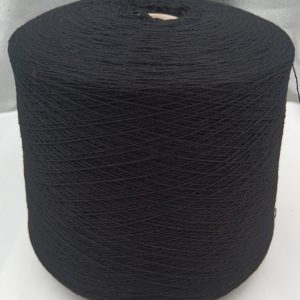How to Work Yarns in cones
How to Work Yarns in cones
Cashmere yarn for knitting machines and cashmere yarn for hand knitting in spools are never (or almost never) treated and must be treated (washed) after processing. This is because machining an untreated yarn is much easier, and there is less risk of the yarn breaking or the needles of the machine breaking.
My first and most important advice is always to make a small sample/canvas (10×10 or better 20×20) and wash it in the washing machine before doing the final work.
This is because cashmere yarns, even if of the same count (fineness) are never all the same. There are many variables on the realization of cashmere yarns, starting from the spinning to the dyeing.
First of all, each spinning mill has its own method and its own market needs and the yarns can be born harder or softer and also have a different dyeing. In addition, there is also a difference between the yarns of the same spinning mill, depending on the colours; the lighter colours are different from the darker colours and melange colours and require little care in the machine processing and in the first washing.
For example, darker colours will always be more raw (less soft) than light colours because in dyeing, more invasive fixing products are used to fix the colour so that the yarn does not lose colour during washing and over time but the fibre itself suffers in softness.
In addition, the type of machine processing is affected. Cashmere tends to swell when it is washed and needs sufficient space for this, so if you want to get the maximum softness you tend to work it with a slightly wider knit.
On the contrary, if you want to obtain the maximum resistance especially in pilling (the classic cashmere knit) you tend to work it with a narrower mesh. In this way you will get a less soft jersey, a little heavier, but much more resistant to pilling.
Here are our washing tips:
Remember to make a small sample/canvas (10×10 or better 20×20) and wash it in the washing machine before doing the final work
1 – Sometimes it may be necessary to evaporate the sample and the garment before or after washing. To evaporate is to pass the iron by releasing the steam on the sample and/or the garment WITHOUT placing the iron on the sample/head, before or after washing.
2 – The following washing tips are general and basic. Before washing the sample, measure it so that you can calculate the returns/returns. Also check well the yield of the sample also in softness and hair, so you can see if it is the case to work it tighter or more rarely, or if you wash it a little more or a little less; in fact if you work it too tight the cashmere will not release its full softness as it tends to swell and if you wash the sample/head less you will get less hair and less softness, vice versa if you wash it for longer in the washing machine. To get more hair, increase the centrifuge, but be careful not to overdo it. If necessary, do more samples and more washing tests, with tighter and sharper machine (or hand) work and different washing times.
3 – All of the above also applies to hand-knitted yarns at the grill or crochet.
TREATMENT IN THE WASHING MACHINE:
Machine washing is carried out when an untreated yarn is machined. The washing indicated is very delicate and the presence of vinegar will be an excellent anti-scale:
– Machine wash at 30° for 7 minutes with very little detergent for delicate garments.
– Rinse the washing machine
– Wash in the washing machine at 30°C for 7 minutes with very little softener and 1/4 cup of white wine vinegar (not red vinegar because it stains).
– Centrifuge at 400 rpm for 5 minutes (or as little as possible).
– Dry flat without exposure to direct sunlight and without squeezing your head (otherwise you risk deforming it).
– For strong and contrasting colours in striped knitwear and jacquard we recommend an initial dry cleaning and washing the garments with plenty of water.
This washing procedure is valid whether it is a sample, finished garment or yarn itself.
WARNING: This washing procedure should be carried out only the first time, then we recommend washing the garments by hand following this procedure:
If you want your pullover to remain soft and fluffy at all times, follow these suggestions:
If you want your pullover to remain soft and fluffy at all times, follow these tips:
Soak it in lukewarm water with a mild detergent (use very little), adding some white wine vinegar in case of scratches or bright colours.
Let it soak for a short time, at most ten to fifteen minutes.
Do not rub it and handle it gently.
Rinse it patiently several times and with plenty of water, always warm, until the water is perfectly clear.
Do not squeeze it but remove the water by pressing gently.
Wrap the pullover in a sponge or towel to remove excess water.
Lay it on a horizontal surface, taking care to avoid direct exposure to the sun.
Let it dry at room temperature, never near a heat source.
Iron it with a strong jet of steam without placing the iron on the pullover.






